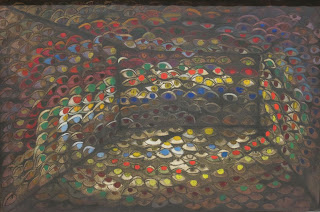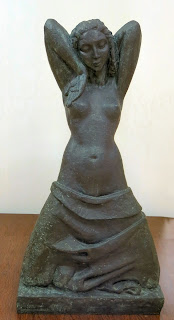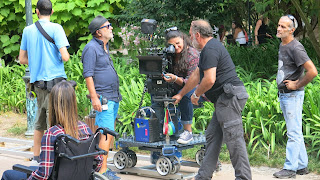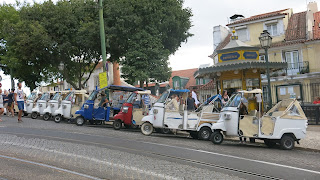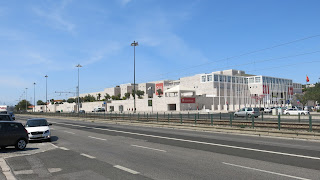We had landed in a picturesque fortified city that was once a Roman settlement.
While planning this trip I noticed on Google maps that the neighboring town to where we were to stay had around four museums. Turns out
Caldas da Rainha was a center for ceramics and sculpture.
Artists and sculptors
José Milhoa,
Antonio Duarte,
Joao Fragosa,
Salvador Barata Feyo all have museum. Only a couple were open, however.
 |
| A Mulher do Gato by José Malhoa, 1886 |
 |
| Portrait of Queen Dona Leonor by José Malhoa, 1926 |
 |
| Model's Rest by José Malhoa, 1894 |
 |
| Orange Seller by Maria de Lourdes de Millo e Castro, 1929 |
 |
| Portrait of Dulce Malta, Artist's Wife by Eduardo Malta, 1940 |
 |
| Sculpture by Rui Roque Gameiro, 1933. |
We saw assorted sculptures and the studio of
Antonio Duarte.
 |
| Antonio Duarte |
Then we were on the road north to
Oporto.
We spent the afternoon roaming before we went to the apartment.
And after arriving at our apartment in
Nova de Gaia, on the south side of the Douro River across from Oporto, we looked out our window:
We began the next day by walking the bridge to Oporto. Even though the Ponte de Dom Luis I was designed by an associate of Gustave Eiffel, it is Eiffel's name on the avenue at the other end of the bridge. While he had partnered with Eiffel on a nearby railroad bridge (at the time the longest single-span in the world), Téophile Seyrig was responsible for this one, which was completed in 1887.
When the
Sao Bento train station was built in 1916, the walls were covered with tiles, like almost every building in Portugal. The blue ones are called
Azulejos, and they often tell stories. The tiles in the entry hall of the train station were done by
Jorge Colaço.
And we were soon introduced to the work of a most prolific local artist.
And other local points of interest.
Our first museum was the
National Museum Soares dos Reis. It was actually Portugal's first national museum as well. Named for the sculptor,
Soares dos Reis, the galleries are filled with work by Portuguese artists.
Mostly old stuff, but we found a few we liked.
 |
| Maccara XXXIX by Nobre, 2014 |
 |
| Preludio by Alexandra de Pinho, 2014 |
 |
| O Canto das Minhocas by Manuela Lemos, 2014. |
Meanwhile, back on the streets:
It was a long walk to the
Museu Serralves, at the far west side of the city (almost six km from the Oporto side of the bridge) The museum, named for the estate on which it was built, is for contemporary Art inside and mostly out.
 |
| Colher de jardineiro (Plantoir) by Claes Oldenburg and Coosje van Bruggen, 2001 |
 |
| Atoms Outside Eggs by Katharina Grosse, 2007 |
 |
| Mario Derosa by Tobias Rehberger, 2003 |
Nothing to get excited about in the surrounding gardens, but back on the streets...
It was dark by the time we crossed the bridge home.
Although the famous local wine is called
Port, it is actually made, stored, and sold on the Gaia side of the river. I was told it was because it got less sun than the Oporto side. And I suppose I should relate the story of Port wine, as it was told to me. The English, it seems, needed to transport wine to their various outposts around the world. Problem was, as the wine continued fermenting on those roiling sea-journeys, it went bad. The people of this region devised a way of adding spirits to their wine, thereby terminating the fermentation and giving it an extra kick. The British moved in and made Porto famous. Even if they did leave off that first
O.
Then a stop out at the coast, in
Foz.
 |
| The Dream of Humanity-tribute to Ferreira de Castro by Jose Rodrigues, 1988 |
It was time to head south again. Our next stop was
Aveiro. Put in a class with Brussels, Prague, and Vienna, when it came to
Art Nouveau architecture, we didn't expect so much more.
The shallow-bottomed
Moliceiro is very important to Aveiro because after the way to the sea was silted in, they had to create lots of shallow canals through the marsh to regain access. The city was soon known as, you guessed it, the
Venice of Portugal. The four panels of the boats are painted with a variety of subjects, from saucy to serious. The language is a combination of Portuguese and Galician.
This building houses the
Art Nouveau Museum, so I guess it was the best of the lot. It is a lovely town, but I don't think Prague has anything to worry about.
 |
| The wood rose maker. |
The above are by
Luis Queimadela. There are fourteen in the show called
InVitro.
The train station was, once again, beautiful.
Looking at these tiles, I realize I should mention that the sides of the boats are very low in order to gather the seaweed (moliceros) which was used as fertilizer on the area farms.
We continued south to
Lisboa, where we stayed just west of the center in
Belem. This was our view.

We took the trolley into town.
We began at
CAM - Contemporary Art Museum which was a huge enclosed compound amid the business district. With jungles, gardens, waterways, and several buildings with different periods of Art. We began at the building marked Modern, but discovered it was anything but.
 |
| Supported Versus Hung by Antonio Charrua, 1969 |
 |
| Movimiento en falso (estabilidad y crecimiento economico) by Damian Ortega, 1999-2003. |
From there we walked through the park to the
Calouste Gulbenkian Museum. All of CAM is his. Please let me share the story
Born in Constantinople, son of an Armenian oil merchant, Gulbenkian studied petroleum engineering in London, got oil rights in Iraq, amassed a fortune, and lived in a Paris apartment (avenue d'Iena). In 1907 he helped arrange the merger of
Royal Dutch Petroleum and
Shell Transportation. He came out a major shareholder, though he was known for keeping just five percent of the companies he put together. Bought tons of art including purchases made when the Soviets sold off artwork from
l'Hermitage. His Paris house was said to be crammed with art. He loaned pieces to the
National Gallery in London and his Egyptian sculptures to the
British Museum. In 1942 he left France for Lisbon and never departed. He died in 1955, having refused a knighthood from King George. The museum opened in 1969.
The collection contains Rembrandts, Rubens, Van Dyke, Frans Halls, Houdin, Rodin, etc. From where we entered the museum, we saw a section of more Modern Art first.
 |
| Portrait of a dancer by Antonio Soares, 1928 |
 |
| Fernando Pessoa - Heteronimous by Antonio Costa Pinheiro, 1978 |
 |
| untitled by Mily Possoz, 1930 |
 |
| Nocturne by Julio dos Reis Pereira, 1929 |
 |
| The Spring or Homage to Jean Goujon by Alfred-Auguste Janniot, 1919-1924 |
Perhaps some will recognize the name of
Janniot from his work on the
Tokyo Palace in Paris and
Rockefeller Plaza in New York. Then the old.
 |
| Figura de Velho by Rembrandt van Rijn, 1645 |
 |
| The Mirror of Venus by Edward Burne-Jones, 1877. |
 |
| Self-Portrait by Edgar Degas, c 1863 |
 |
| Lady and Child in a Punt under the Willows by John Singer Sargent, 1887 |
We took the Metro across town on the way to visit the
Vieira de Silva Museum. We were introduced in the subway.
And some of their friends had Art shown as well, such as
Jean Dubuffet and
Paul Klee.
 |
| Borne au Logos V by Jean Dubuffet, 1967. |
 |
| Offrande fanee by Paul Klee, 1937 |
They were shooting something when we walked through Jardim da Estrella.
Then we hopped on the No. 28 Trolley for a tour around town.
The next day we took a train west to Sintra. Departing from the ornate Rossio station.
CLICK HERE FOR ART IN ROSSIO.
Once the political center of Portugal, Sintra has had royal relations since 1373 when some King Ferdinand had the city walled and given to his fiancé. It is now a UNESCO World Heritage Site. Our first stop, of course, was the Art museum.
 |
| Polyamory by Laranjeira Santos, 2000 |
 |
| Arc by Dorita Castel-Branco, 1991 |
Lots of Dorita.
 |
| Bouncing Axis by Dorita de Castel-Branco |
 |
| Dorita |
 |
| Serra de Sintra by Manuel da Silva, 1982 |
CLICK HERE TO SEE MORE.
Outside.
On the other side of town, along the way to the older part of town, there was a show called Dreams and Queens. Works by seventeen artists lined the way up the hill.
 |
| Buardia do Futuro by J. Alves, 2015 |
 |
| Town Hall |
 |
| Train Station |
Back in Lisboa:
And there was still time, after we got back to our apartment, to take a walk over to the Belem Tower.
It was just a good stretch of the leg over to the center of Belem where the big - and I mean big - attraction is the Jeronimos Monastery.
The second biggest is the Pasteis de Belem.
The third biggest is the Cultural Center of Belem.
The attraction here, is the Museu Coleção Berardo.
 |
| L'Arbre Biplan by Jean Dubuffet, 1968 |
Inside was a massive array of Contemporary Art with some Modern and Pop thrown in. This is hardly a representative selection, but I have tried to include some important artists I am not always able to show.
 |
| Watchman, What of the Night by Roberto Matta, 1968 |
 |
| Study for Bull in the Sun by Arshille Gorky, c 1942 |
 |
| Black Spray by Alexander Calder, 1956 |
 |
| Composition by Fernand Léger, 1953 |
 |
| Café Man Ray by Man Ray, 1948 |
 |
| La Cohorte invincible by Giorgio de Chirico, 192 |
 |
| Balance by Francis Picabia, 1919-20 |
 |
| Severa,b;a bu Frank Stella, 1995 |
 |
| Backdrop for 'The Magic Flute, Act II, Scene 3 (Lincoln Center) by Marc Chagal, 1965-67 |
 |
| Flesh Nude behind Brown Door by George Segal, 1978 |
 |
| Eight Sided Pyramid by Sol LeWitt, 1992 |
 |
| Reclining Figure-Arched Leg, 4 of 6 by Henry Moore, 1969-70 |
I'd say the fourth biggest thing in Belem, is this
Big Racoon.
 |
| Big Racoon by Bordalo II, 2015. |
Closer to Lisbon is a reclaimed industrial center called the LX Center. It was funky, as expected, but expensive. Doesn't cost to take pictures, though.
It was our last day in Lisboa, and we still had one more museum to see. The
National Museum of Contemporary Art at Chiado was a massive building covering two blocks. All sorts of interesting galleries - I mean the physical gallery, not the Art. There were glass catwalks and whole sections painted strictly white. The art was mixed.
 |
| Adam and Eve by Ernesto Canto da Maia, 1828-30 |
 |
| untitled by Jorge Vieira |
 |
| untitled by Jorge Vieira, 1957 |
 |
| Effect of Light by Adriano de Sousa Lopes, 1914 |
 |
| The Blue Blouse by Adriano de Sousa Lopes, 1927 |
 |
| Seaweed harvesters by Adriano de Sousa Lopes, 1939 |
 |
| The Rapture of Miss Europe by Niklas Skapinakis, 1973. |
The Metro Art was wonderful. But some stations were even better. The Oriente Station would come under this category. In 1998, 500 years after Vasco da Gamba's voyage to India, new murals with an oceanic theme were installed. And wouldn't you know it. Look who was one of the artists:
 |
| Submersão Atlântida by Hundertwasser, 1998 |
 |
| Yayoi Kussama from Japan, 1998 |
 |
| Abdoulaye Konate from Mali, 1998 |
And now some last shots around Lisboa.
Then it was back to
Copenhagen for one last afternoon.
 |
| Wormholes by Jonas Pihl |
 |
| Diversity |
 |
| Art by Oral Kerr |
 |
| Oral Kerr |
 |
| Fire Piller by Arnaldo Pomodoro, 1985, at Amaliehavn |
And that's all I've got. Hope you enjoyed the trip.






























